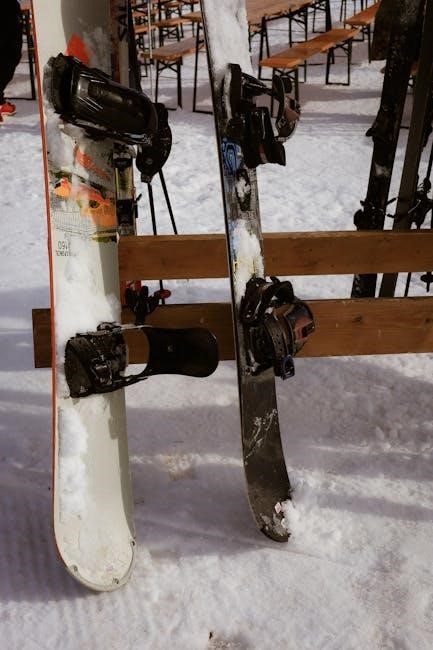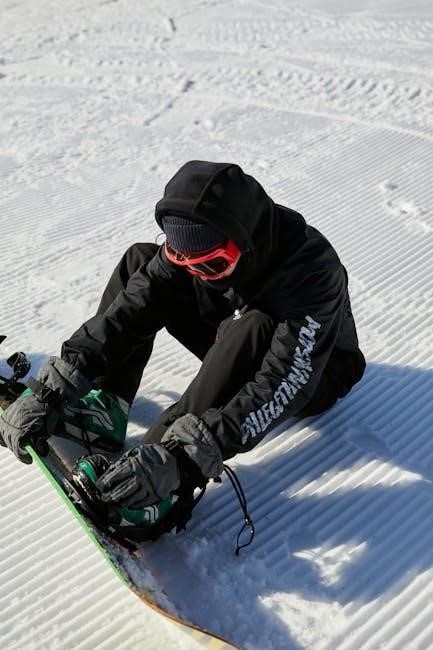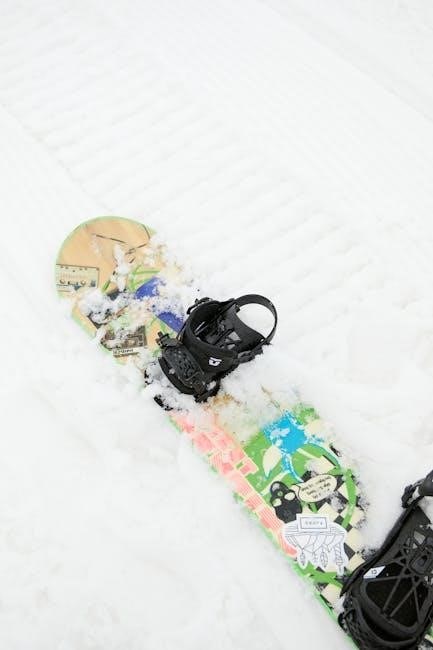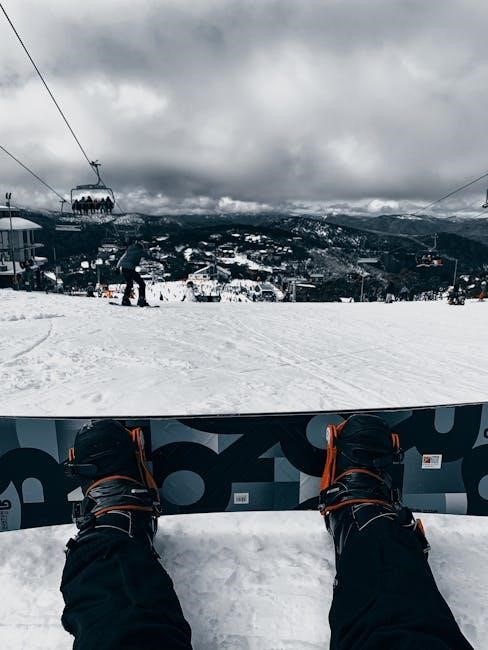Choosing the right snowboard binding size is crucial for optimal performance and comfort. This guide helps you understand how to select bindings that fit your boots perfectly, ensuring proper support and control on the slopes.
1.1 Importance of Proper Binding Size
Proper binding size is essential for comfort, performance, and safety on the snowboard. Ill-fitting bindings can cause discomfort, affect responsiveness, and lead to fatigue. A binding that is too small may restrict boot movement, while one that is too large can result in a sloppy fit, reducing control. Ensuring the right size ensures optimal support and allows for precise maneuverability. Correct fit also prevents pressure points and blisters, enhancing your overall riding experience. Properly sized bindings are crucial for maximizing performance and confidence on the slopes, making them a cornerstone of a successful snowboarding setup.
1.2 Overview of the Guide
This comprehensive guide provides a detailed approach to selecting the ideal snowboard bindings. It covers essential factors such as boot compatibility, binding types, and rider preferences. The guide includes standardized size charts and expert tips to help you navigate the selection process. Whether you’re a novice or an experienced rider, this resource ensures a perfect fit, optimal performance, and enhanced comfort. By following the outlined steps, you’ll gain confidence in choosing bindings that align with your riding style and snowboard setup, making your time on the mountain more enjoyable and effective.

Understanding Snowboard Binding Sizes
Snowboard binding sizes vary, with options from S to XL. Boot size is crucial, and proper fit ensures optimal performance and comfort. Ensure your boots fit snugly within the bindings for the best experience.
2.1 Factors Affecting Binding Size
Boot size and brand significantly impact binding size, as sizing varies between brands. Riding style also plays a role, with freestyle riders often preferring softer flex, while all-mountain riders may need stiffer bindings. Stance width and personal comfort further influence the choice. Proper fit is essential to avoid pressure points or a sloppy feel. Testing bindings with your boots ensures compatibility and optimal performance. Always consider these factors to select bindings that match your needs for the best snowboarding experience.
2.2 Standard Binding Size Charts
Standard binding size charts provide a general guide to help riders select the right bindings based on their boot size. These charts typically categorize bindings into sizes like Small, Medium, and Large, offering a range of boot sizes each can accommodate. However, sizing can vary between brands, so it’s essential to refer to the specific manufacturer’s chart. Using these charts ensures a proper fit, preventing issues like pressure points or excessive movement. They simplify the selection process, allowing riders to focus on other features once they’ve determined their size range.

Snowboard Boot and Binding Compatibility
Ensuring a snug fit between your boots and bindings is crucial for optimal support and performance. This guide helps you choose the right size and style.
3.1 How Boot Size Affects Binding Fit
Boot size plays a critical role in determining binding fit. Ill-fitting bindings can lead to discomfort, reduced control, and poor performance. Ensure your boots fit snugly within the bindings without causing pressure points. If your boots are too large, they may not secure properly, while smaller boots might leave excessive space, affecting responsiveness. Proper alignment and tightness are essential for optimal support and maneuverability. Always check compatibility charts and test bindings with your boots to achieve the best fit for a seamless snowboarding experience.
3.2 Ensuring Boot and Binding Compatibility
Ensuring boot and binding compatibility is essential for a comfortable and responsive ride. Start by checking the manufacturer’s size charts to match your boot size with the binding. Consider the boot’s width and the binding’s strap adjustability to avoid pressure points. Test the fit by placing the boot in the binding and checking for snugness without excessive tightness. Additionally, ensure the binding’s flex aligns with your riding style and boot stiffness. Proper compatibility enhances control, reduces fatigue, and improves overall performance on the snow.

Types of Snowboard Bindings
Snowboard bindings come in three main types: Strap-In, Step-On, and Hybrid. Each offers unique features catering to different riding styles and preferences for comfort and performance.
4.1 Strap-In Bindings
Strap-In bindings are the most common type, offering a secure and customizable fit. They feature adjustable straps that wrap around the boot, providing excellent support and control. Ideal for all riding styles, they suit beginners and advanced riders alike. The straps allow for precise adjustments, ensuring a snug fit that minimizes foot movement. This design is popular for its reliability and versatility, making it a favorite among snowboarders who value both performance and comfort. Proper sizing is essential to avoid pressure points and ensure optimal responsiveness on the mountain.
4.2 Step-On Bindings
Step-On bindings offer unparalleled convenience, with a simple “step-in” design that eliminates the need for straps. They feature a boot and binding system that clicks into place, providing quick entry and exit. This style is ideal for riders seeking efficiency, especially in deep snow or frequent starts and stops. However, compatibility is key, as they require specific boots with matching technology. While they lack the customization of strap-in bindings, their ease of use makes them a popular choice for casual to intermediate riders who value simplicity and speed.
4.3 Hybrid Bindings
Hybrid bindings combine elements of strap-in and step-on systems, offering a versatile option for riders. They provide the ease of step-on technology with the adjustability of straps, allowing for a customizable fit. This design caters to a wide range of riding styles, from casual cruising to aggressive carving. Hybrid bindings are ideal for those who want the convenience of step-on systems but still value the precision and control of traditional straps. They are durable, adaptable, and suitable for various snowboarding conditions, making them a great choice for riders seeking a balance between simplicity and performance.

Riding Style and Stance
Your riding style and stance significantly impact your snowboarding experience. Understanding how these elements influence binding size ensures a comfortable and performance-enhancing setup on the slopes.
5.1 How Riding Style Impacts Binding Size
Your riding style plays a key role in determining the ideal binding size. Freestyle riders may prefer softer bindings for flexibility, while all-mountain riders often opt for medium flex. Powder enthusiasts might choose stiffer bindings for better control. The size and responsiveness of bindings should align with your riding preferences to ensure optimal performance. For instance, a larger binding may suit aggressive riders needing stability, whereas smaller bindings offer easier maneuverability for tricks. Matching your binding size to your style ensures comfort and enhances your overall snowboarding experience. Proper fit is essential for responsiveness and control on the slopes.
5.2 Stance Width and Its Importance
Stance width significantly impacts your snowboarding experience, affecting balance, control, and comfort. A wider stance often enhances stability and leverage, particularly for taller riders, while a narrower stance can improve agility. Proper stance width aligns with your binding size, ensuring optimal performance. Most snowboards have pre-drilled holes for binding placement, allowing customization. Starting with a centered stance is recommended, as it provides balanced control. Adjustments can be made based on personal preference and riding style. Correct stance width ensures better weight distribution, making turns more precise and enjoyable. It’s a critical factor in achieving a comfortable and responsive ride. Proper alignment is key to maximizing performance and comfort on the slopes.

Snowboard Binding Mounting Patterns
Understanding snowboard binding mounting patterns is essential for ensuring compatibility and proper installation. Common patterns include 2×4, 4×4, and channel systems, each requiring specific hardware.
6.1 Understanding Mounting Patterns
Snowboard bindings use specific mounting patterns to attach to the board. The most common are the 2×4 and 4×4 systems, which refer to the number of screws. Burton’s 3D and channel systems offer more flexibility. Each pattern requires compatible hardware to ensure a secure fit. Proper alignment with the board’s insert pattern is crucial for performance and safety. Mounting incorrectly can lead to poor control or damage to the board. Always check compatibility before installation to avoid issues on the mountain.
6.2 Compatibility with Snowboard Holes
Ensuring your bindings are compatible with your snowboard’s hole pattern is vital. Most boards use standard 2×4 or 4×4 mounting systems, but some brands, like Burton, feature unique channel systems. Check that your bindings match the board’s configuration to avoid compatibility issues. Using incorrect hardware or misaligning the bindings can lead to poor performance or damage. Always refer to the manufacturer’s guidelines for specific compatibility details. Proper alignment ensures optimal responsiveness and safety, making it essential to verify before mounting.

Choosing the Right Binding Flex
Binding flex is crucial for performance, with stiffer bindings offering more response and softer bindings providing flexibility. Choose based on your weight and riding style for optimal control.
7.1 Binding Flex and Rider Weight
A rider’s weight significantly impacts the ideal binding flex. Lighter riders benefit from softer flex bindings for easier maneuverability, while heavier riders need stiffer bindings to maintain control and stability.
7.2 Flex Levels for Different Riding Styles
Flex levels in bindings are tailored to suit various riding styles. Freestyle riders often prefer softer flex bindings for easier maneuverability and tricks, while all-mountain riders opt for medium flex for balanced performance. Powder riders benefit from stiffer bindings to maintain control in deep snow. The flex level should align with the rider’s style to ensure optimal responsiveness and comfort. Softer flex is ideal for casual cruising, and stiffer flex suits aggressive carving. Matching the binding flex to the riding style enhances performance and overall snowboarding experience. Always consider your primary riding style when selecting binding flex for the best results.

Features to Consider in Snowboard Bindings
Key features include adjustable straps, cushioning, and durability. Look for bindings with customizable fit, shock absorption, and materials that withstand harsh conditions, ensuring comfort and performance.
8.1 Adjustable Features
Adjustable features in snowboard bindings allow for a customizable fit, enhancing comfort and performance. Straps, highbacks, and forward lean can often be tailored to suit individual preferences. Many bindings offer tool-free adjustments, making it easy to fine-tune on the go. Additionally, some models feature adjustable flex, catering to different riding styles. These adaptable components ensure that bindings can grow with a rider’s skill level, providing long-term value. Proper adjustment is key to avoiding pressure points and ensuring responsiveness, making adjustable features a vital consideration for any snowboarder.
8.2 Comfort and Support Features
Comfort and support in snowboard bindings are essential for long days on the mountain. Look for features like cushioned straps, padded highbacks, and shock-absorbing materials to reduce fatigue and enhance ride quality. Adjustable straps ensure a snug, pressure-free fit, while supportive highbacks provide stability and control. Many bindings also incorporate ergonomic designs to align with the natural shape of your boots, minimizing discomfort and maximizing energy transfer. Proper support and comfort enable better performance and a more enjoyable experience, making these features a priority for riders of all levels.

Common Mistakes to Avoid
Common mistakes include choosing bindings too small or large for your boots, ignoring stance preferences, and not ensuring compatibility with your snowboard’s mounting pattern.
9.1 Incorrect Boot Size for Bindings
Incorrect boot size for bindings is a common mistake that can lead to poor performance and discomfort. Boots that are too large or small for the bindings can cause pressure points or a sloppy fit, affecting control and responsiveness. It’s essential to ensure your boot size aligns with the binding’s size range, as different brands may have varying fits. Testing the bindings with your boots in person is highly recommended to avoid sizing mismatches. Proper fit ensures optimal support, comfort, and performance on the snow.
9.2 Ignoring Stance and Flex Preferences
Overlooking stance and flex preferences is a common error that can significantly impact your snowboarding experience. A stance that’s too narrow or wide may cause discomfort and affect balance, while incorrect flex levels can make turning difficult or unresponsive. Softer flex bindings are ideal for beginners, offering forgiveness, while stiffer options suit advanced riders needing precision. Always consider your riding style and weight when selecting flex. Testing bindings on your board ensures proper stance setup and flex alignment, enhancing performance and comfort. Prioritize these factors to optimize your snowboarding enjoyment.

Fine-Tuning Your Bindings
Fine-tuning your bindings involves adjusting strap tightness and forward lean to match your riding style. Proper adjustments enhance responsiveness, control, and overall snowboarding performance and comfort.
10.1 Adjusting Strap Tightness
Proper strap tightness is essential for both comfort and performance. Adjust the straps so they fit snugly around your boots without causing pressure points. Start by tightening the toe strap first, ensuring it holds your boot firmly. Then, adjust the ankle strap to provide support while allowing enough flexibility for movement. Avoid overtightening, as this can restrict blood flow and lead to discomfort. Test the fit by moving your feet slightly; there should be no excessive sloppiness. Fine-tune the straps on the slopes if needed, ensuring optimal responsiveness and control throughout your ride.
10.2 Setting Forward Lean
Forward lean adjusts the angle of your bindings to match your riding style. It enhances responsiveness and control by positioning your body naturally over the board. To set it, loosen the forward lean adjustment screws on the binding’s highback. Use an Allen wrench to tilt the highback forward or backward to your preferred angle. For all-mountain or freeride styles, a slightly steeper lean (around 15-20 degrees) is ideal. For freestyle or casual cruising, a more upright position (5-10 degrees) provides better flexibility. Ensure the highback is snug against your boot for consistent performance and adjust as needed based on your stance and terrain.
Choosing the right snowboard bindings ensures optimal performance, comfort, and control. Proper fit, compatibility, and adjustment are key for an enjoyable riding experience tailored to your needs and style.
11.1 Summary of Key Points
11.2 Final Tips for Choosing the Right Bindings
When selecting bindings, always test them with your boots to ensure a snug, comfortable fit. Consider your riding style and terrain preferences to match the right flex level. Adjust strap tightness and forward lean for optimal control. Ensure compatibility with your snowboard’s mounting pattern. Don’t hesitate to seek advice from experts or use online size guides for accuracy. Prioritize features like adjustability, support, and durability to enhance performance. By thoughtfully considering these factors, you’ll find bindings that elevate your snowboarding experience and keep you riding confidently all season long.
